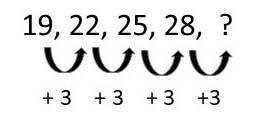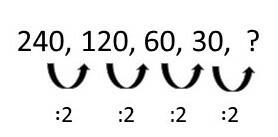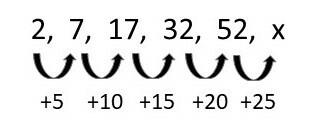At number sequences they are sets of numbers that follow a pre-established order, that is, there is a pattern between them.
The formation law or general term of a sequence is a formula that defines how the elements of the sequence are formed. From it, we can determine any term in a sequence.
In the study of numerical sequences, the arithmetic progressions and geometric progressions.
Are you interested in this subject and want to learn more?! Check out, below, a list of number sequence exercises, all with full resolution.
Index
- Numerical Sequence Exercises
- Resolution of question 1
- Resolution of question 2
- Resolution of question 3
- Resolution of question 4
- Resolution of question 5
- Resolution of question 6
- Resolution of question 7
- Resolution of question 8
- Resolution of question 9
- Resolution of question 10
- Resolution of question 11
- Resolution of question 12
Numerical Sequence Exercises
Question 1. Determine the next number in the sequence:
19, 22, 25, 28, …
Question 2. Determine the 5th sequence number:
42, 38, 34, 30, …
Question 3. What number continues the sequence?
12, 24, 48, 96, …
Question 4. What's the next number?
240, 120, 60, 30, …
Question 5. Determine the value of x in the sequence:
6, 7, 9, 12, 16, 21, x
Question 6. What is the value of x in the sequence?
3, 6, 8, 16, 18, 36, x
Question 7. Determine the value of x in the sequence:
5, 8, 7, 10, 9, 12, 11, x
Question 8. Find the value of x:
2, 7, 17, 32, 52, x
Question 9. Determine the next number in the sequence:
4, 9, 15, 23, 34, …
Question 10. Determine the overall term of the sequence:
4, 9, 16, 25, 36, …
Question 11. Determine the general term of the sequence:
-4, 9, -16, 25, -36, …
Question 12. What is the general term of the sequence?
5, 10, 17, 26, 37, …
Resolution of question 1
Note that each number corresponds to its predecessor plus 3:

Therefore, the next number in the sequence is 31, since 28 + 3 = 31.
Resolution of question 2
Note that each number corresponds to its predecessor minus 4:

So the next number is 26, since 30 – 4 = 26.
Resolution of question 3
Note that each number corresponds to its predecessor multiplied by 2

So the next number is 192, since 96 × 2 = 192.
Resolution of question 4
Note that each number corresponds to its predecessor divided by 2:

So the next number is 15, since 30: 2 = 15.
Resolution of question 5
- Free Online Inclusive Education Course
- Free Online Toy Library and Learning Course
- Free Online Math Games Course in Early Childhood Education
- Free Online Pedagogical Cultural Workshops Course
Note that there is a pattern:

Therefore, x = 21 + 6 = 27.
Resolution of question 6
Note that there is a pattern, multiply by 2 and add 2, alternately.

Therefore, x = 36 + 2 = 38.
Resolution of question 7
Note that there is a pattern, add 3 and subtract 1, alternately.

Therefore, x = 11 + 3 = 14.
Resolution of question 8
Note that there is a pattern:

Therefore, x = 52 + 25 = 77.
Resolution of question 9
In this case, the pattern is observed in a second step.

To know the next number in the first row, we must first know what the next number in the second row is.
By the observed pattern, in the third row, the next number in the second row is 15, since 11 + 4 = 15.
So the next number in the first row is 34 + 15 = 49.
Resolution of question 10
We want to identify the general term of the sequence:
4, 9, 16, 25, 36, …
Note that the terms are perfect squares. So, we can write it like this:
2², 3², 4², 5², 6², …
Now, considering only the base of each power, see that each one of them corresponds to the position it occupies in the sequence added to the number 1.
We can rewrite it as:
(1+ 1)², (2 + 1)², (3 + 1)², (4 + 1)², (5 + 1)², …
Therefore, the general term is:
Resolution of question 11
The difference between the sequence below and the sequence of the previous exercise, is that in this one, the odd position terms have a negative sign.
-4, 9, -16, 25, -36, …
We can rewrite it as:
Therefore, the general term is:
Resolution of question 12
We want to find the general term of the sequence:
5, 10, 17, 26, 37, …
Note that each term in this sequence corresponds to a perfect square plus 1, that is, 5 = 4 + 1, 10 = 9 + 1, 17 = 16 + 1, and so on.
So we can rewrite it as:
4 + 1, 9 + 1, 16 + 1, 25 + 1, 36 + 1, …
Considering the general term of the sequence (4, 9, 16, 25, 36, …) of exercise 10, the general term of this other sequence is:
You may also be interested:
- Fibonacci Sequence
- Lesson Plan - 2 in 2 Number Sequence
- Lesson Plan - Numeric Sequence of 5 in 5
- List of arithmetic progression exercises
- List of Geometric Progression Exercises
The password has been sent to your email.

